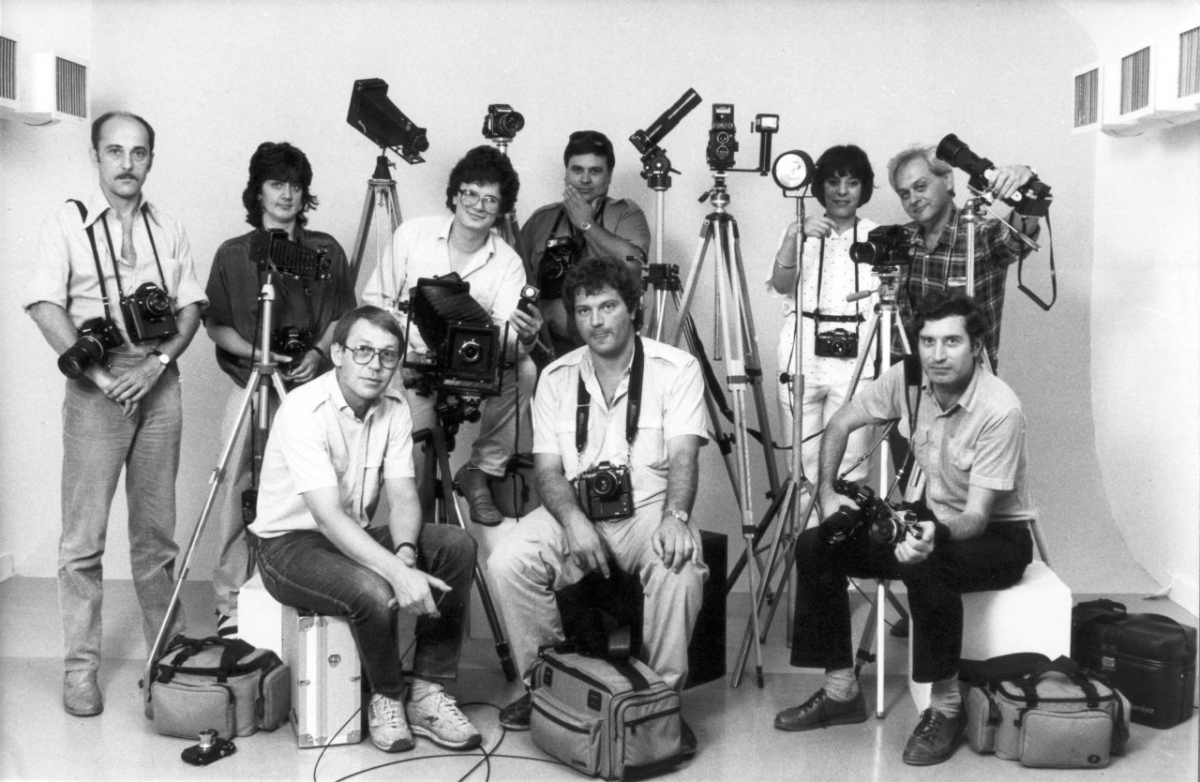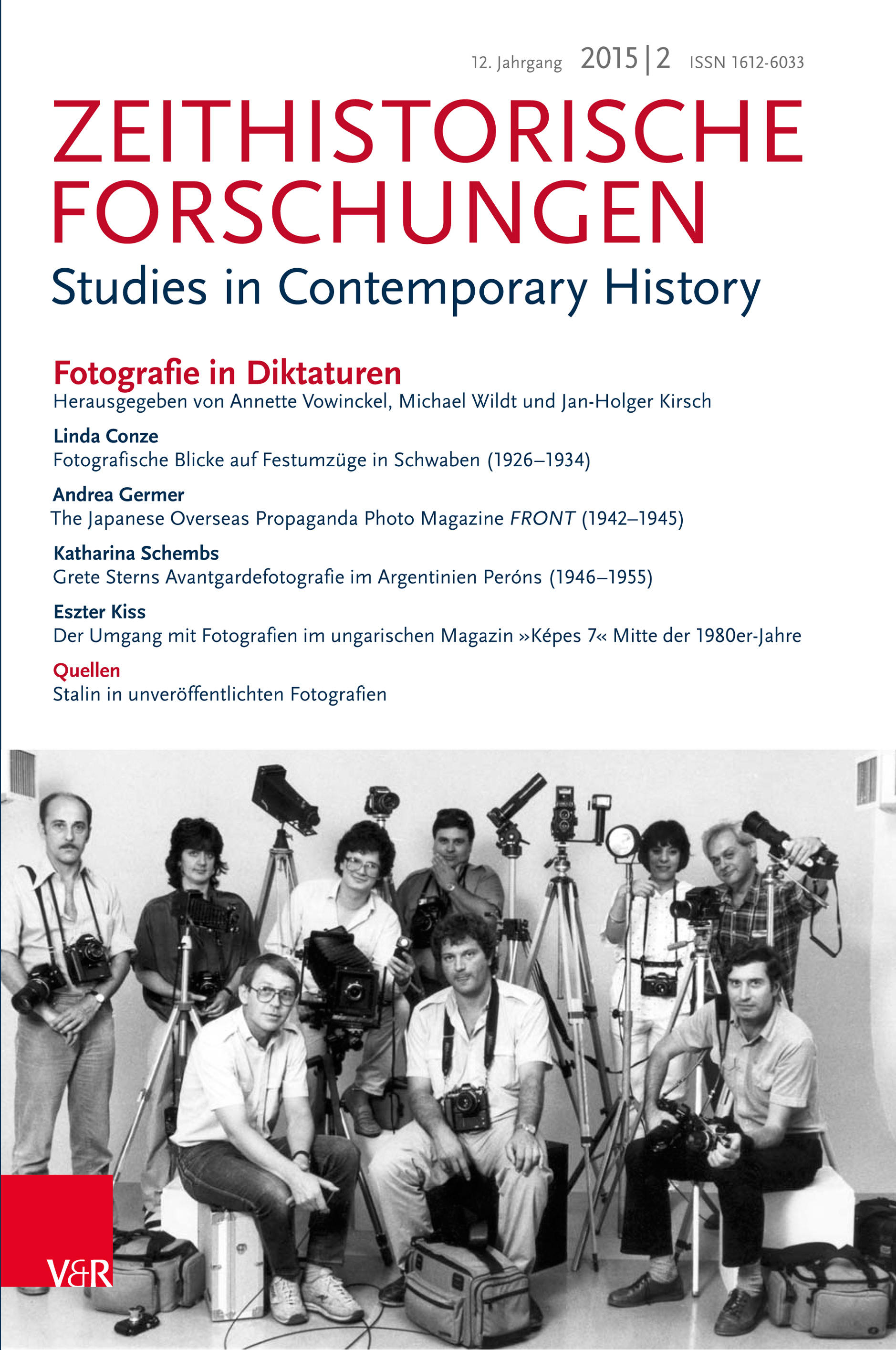Heft 2 / 2015
Aufsätze | Articles
Die Ordnung des Festes /
Die Ordnung des BildesFotografische Blicke auf Festumzüge in Schwaben (1926–1934)
AbstractAlbert Gehring, ein 1897 geborener Einwohner des Ortes Ditzingen, setzte in den 1920er- und 1930er-Jahren das Kleinstadtleben seiner schwäbischen Heimat ins Bild. Besonders häufig findet sich im Konvolut von rund 1.000 Glasplattennegativen das Motiv des Festumzuges und damit eines Elements von Festkultur, welches oft als die Grundform nationalsozialistischen Kultes und als erfolgreiches Mobilisierungsinstrument beschrieben worden ist. Gehrings Fotografien ermöglichen am lokalen Beispiel eine differenzierte Perspektive auf die Aushandlungs- und Aneignungsprozesse in der Praxis der Festumzüge. Haben sich die äußere Form der Umzüge, ihre Symbolik und Choreographie – also das, was sie zu vermitteln suchten – mit der nationalsozialistischen Machteroberung von 1933 verändert? Und ging mit diesem möglichen Wandel auch eine veränderte Visualisierung durch Albert Gehring einher? Im Fokus stehen damit fotografische Positionen zu der sich wandelnden Festpraxis des Umzuges: Die Ordnung des Bildes wird in ein Verhältnis zur Ordnung des Festes gesetzt, um Erkenntnisse über die Rolle von Fotografie in Prozessen von Mobilisierung und Partizipation an der Schwelle zur NS-Diktatur zu erlangen.
∗ ∗ ∗
The Law of the Parade / The Law of the Image. Photographic Gazes on Festive Parades in Swabia (1926–1934)Albert Gehring, born in Ditzingen in the southwest of Germany in 1897, regularly captured the events of everyday life in his village with his plate camera in the 1920s and 1930s. Festive parades, often described as an essential part of the National Socialist cult and an efficient instrument of mobilization, are a prevalent subject in his photographic collection, which comprises some 1,000 glass plate negatives. As a historical source, Gehring’s pictures shed a nuanced light on typical examples of this specific social practice on a local level. Did the outward appearance of the parades, their symbols and ritual choreographies change after the Nazi seizure of power in 1933? And was such a change accompanied by a change in their photographic visualization by Albert Gehring? The article focuses on photographic perspectives of festive parades, understanding the image as the product of a certain point of view. The principles underlying the images will be compared and contrasted with those governing the festive practice to gain insight into how photographs contributed to processes of mobilization during the transition from Weimar democracy to Nazi dictatorship.
Adapting Russian Constructivism and Socialist Realism
The Japanese Overseas Photo Magazine FRONT (1942–1945)
AbstractModeled after the Soviet propaganda magazine SSSR na stroike (›USSR in Construction‹, published 1930–1941, 1949), the Japanese overseas propaganda photo magazine FRONT (1942–1945) provided visual propaganda for the so-called ›Greater East Asia Co-Prosperity Sphere‹, a concept that was proclaimed in 1940 and served to disguise Japan’s quest for hegemony in Asia. Employing the aesthetics of Russian Constructivism and Socialist Realism of SSSR na stroike, FRONT created a visual aesthetic that could be termed Japanese Co-Prosperity Realism. Its dynamic and modernistic design was a transculturally inspired practice by Japanese photographers, graphic designers, journalists and producers of visual media, some of whom had been left-wing intellectuals or had lived and worked in the Soviet Union. In a comparative perspective, this paper carves out the political, cultural and gendered semantics of the (in)visibility of power, political religion and ethnic diversity that such aesthetics entailed. It explores some of the shifting backgrounds against which photographic techniques were enacted, from their avant-garde beginnings to their application in authoritarian regimes.
∗ ∗ ∗
Russischer Konstruktivismus und Sozialistischer Realismus in der japanischen Auslandspropaganda. Die Fotoillustrierte »FRONT« (1942–1945)Die sowjetische Propagandazeitschrift »SSSR na stroike« (»UdSSR im Bau«, 1930–1941, 1949) diente als Vorbild für die japanische Auslands- und Fotoillustrierte »FRONT« (1942–1945). Letztere lieferte die visuelle Propaganda für die »Großostasiatische Wohlstandssphäre«, ein Konzept, das 1940 verkündet wurde und den japanischen Herrschaftsanspruch in Asien verschleiern bzw. beschönigen sollte. Mit Anleihen des Russischen Konstruktivismus und Sozialistischen Realismus aus »SSSR na stroike« schufen die Macher von »FRONT« eine visuelle Ästhetik, die man »Realismus der japanischen Wohlstandssphäre« nennen könnte. Dessen dynamisches und modernistisches Design war das Ergebnis einer transkulturell inspirierten Praxis japanischer Fotografen, Grafikdesigner, Journalisten und Produzenten visueller Medien, von denen einige ehemals linke Intellektuelle waren oder in der Sowjetunion gelebt hatten. In vergleichender Perspektive arbeitet der Aufsatz die politischen, kulturellen und geschlechtlichen Semantiken der (Un-)Sichtbarkeit der Macht, politischer Religion und ethnischer Vielfalt dieser visuellen Ästhetik heraus. Die sich wandelnden fotografischen Techniken werden im jeweiligen Kontext diskutiert, von ihren Avantgarde-Anfängen bis zu ihrer Nutzung in autoritären Regimen.
Traumbilder
Grete Sterns Avantgardefotografie im Argentinien Peróns (1946–1955)
AbstractUnter denen, die vor der NS-Diktatur flüchteten, waren nicht wenige bildende Künstler/innen – so auch die deutsch-jüdische Bauhausfotografin Grete Stern (1904–1999), die 1935/36 nach Argentinien emigrierte. Trotz autoritärer politischer Tendenzen genoss sie dort deutlich mehr künstlerische Freiheit. Während der ersten beiden Amtszeiten des demokratisch gewählten Präsidenten Juan Domingo Perón (1946–1955), der sich vor allem in der staatlichen Kontrolle der Medien an den europäischen Faschismen orientierte, auf den sich wegen seiner Sozialpolitik jedoch auch linksgerichtete Bewegungen beriefen, veröffentlichte Stern in der Zeitschrift »Idilio« (»Idylle«) eine Serie von Fotomontagen. Nach einem Überblick zur peronistischen Kulturpolitik bildet die Einordnung dieser Montagen, die zusammen mit einer Traumdeutungs-Kolumne erschienen, den Schwerpunkt des Aufsatzes. In subtiler Weise kritisierte Stern soziokulturelle Missstände der Zeit. Zu einem ihrer Hauptthemen wurden die Geschlechterbeziehungen – ein Gebiet, auf dem sich das peronistische Regime nicht zuletzt in seiner umfangreichen Bildpropaganda rühmte, tiefgreifende Veränderungen hervorgebracht zu haben.
∗ ∗ ∗
Dream Images. Grete Sternʼs avant-garde photography in Peronist Argentina (1946–1955)Among the refugees fleeing from the Nazi dictatorship were many artists – including the German-Jewish photographer Grete Stern (1904–1999), who had been trained at the Bauhaus and emigrated to Argentina in 1935/36. In spite of the authoritarian political tendencies, she enjoyed much greater artistic freedom there. During the first two terms of the elected president Juan Domingo Perón (1946–1955), whose main model for strict media control were European fascist regimes but who – because of his social policy – was later also invoked by leftist groups, Stern published a series of photomontages in the magazine Idilio (›Idyll‹). Following an overview of Peronist cultural policy, the focus of this article is the contextualization of these montages, which were published together with a column on dream interpretation. Stern subtly criticized sociocultural injustices of her time, one of her main topics being the relationship between genders. In this field in particular, the Peronist regime boasted in its extensive visual propaganda of having brought about significant changes.
Vorbilder, Spiegelbilder und Feindbilder
Der Umgang mit Fotografien im ungarischen Magazin »Képes 7« Mitte der 1980er-Jahre
AbstractIn der Volksrepublik Ungarn erschien seit 1986 auf Initiative des Zentralkomitees der Ungarischen Sozialistischen Arbeiterpartei (MSZMP) sowie des Politbüros die Publikumszeitschrift »Képes 7« (»Bebilderte Woche« oder »Die bebilderten Sieben«), die den Lesern als Vorzeigeprojekt der modernen sozialistischen Magazingestaltung angekündigt wurde. Anhand des turbulenten ersten Erscheinungsjahrs von »Képes 7« werden unterschiedliche Praktiken des Umgangs mit Fotografien beleuchtet. Wie sah die bislang kaum untersuchte sozialistische Bildpolitik bzw. Bildlenkung im Alltag aus? Die Bandbreite der Haltungen und Handlungen der Akteure reichte von der Übernahme von Fotos aus westlichen Zeitschriften (»Scherenarbeit«) über die Produktion eigener Reportagen bis hin zu massiven Konflikten um einzelne Bilder oder Themenfelder. Näher betrachtet werden Personen und Institutionen, die am Prozess der Bilderzeugung und massenwirksamen Verbreitung beteiligt waren. Der Aufsatz stützt sich auf die veröffentlichten Ausgaben von »Képes 7«, auf zeitgenössisches Archivmaterial sowie auf eigene Interviews mit ausgewählten Akteuren.
∗ ∗ ∗
Ideal Images, Mirror Images, Demonising Images. The Handling of Photographs in the Hungarian Magazine Képes 7 in the mid-1980sFounded on the initiative of the Central Committee of the Hungarian Socialist Workers’ Party (MSZMP) and the Politburo, the weekly magazine Képes 7 was published in the Hungarian People’s Republic since 1986. The periodical was proclaimed a showcase of modern socialist magazine design. Based on the first eventful year of Képes 7, the article highlights different practices in the handling of photographs. What form did socialist ›image control‹ – a specific aspect of visual history, scarcely researched until now – take during the eighties in the day-to-day work at the editorial departments of illustrated magazines? The broad range of divergent attitudes and actions of the protagonists extends from copying photographs from Western magazines (›cut and paste‹) to the production of picture stories using original photographs and to massive conflicts about certain photos or subjects. Special attention is drawn to individuals or institutions who were involved in the process of creating photographs and presenting them to wider audiences. The article is based on the published issues of Képes 7, on archival sources and on interviews with some of the protagonists.
Debatte | Debate
Besprechungen | Reviews
Zitation
Redaktionsschluss
Erweiterte Suche

